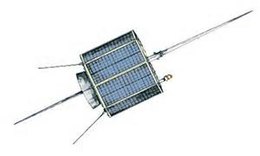 Image Of The Satellite Amsat-OSCAR 7 | |
| Mission type | Amateur radio satellite |
|---|---|
| Operator | AMSAT |
| COSPAR ID | 1974-089B |
| SATCAT no. | 7530 |
| Website | amsat |
| Mission duration | Planned: 10 years Elapsed: 50 years and 22 days |
| Spacecraft properties | |
| Launch mass | 28.8 kilograms (63 lb) |
| Dimensions | 36.0 cm x 42.4 cm octahedron |
| Start of mission | |
| Launch date | 15 November 1974, 17:11 UTC |
| Rocket | Delta 2310 |
| Launch site | Vandenberg SLC-2W |
| Orbital parameters | |
| Reference system | Geocentric |
| Regime | Low Earth |
| Perigee altitude | 1,447.5 kilometers (899 Mi) |
| Apogee altitude | 1,465.6 kilometers (910 Mi) |
| Inclination | 101.59 degrees |
| Period | 114.9 Minutes |

| |
AMSAT-OSCAR 7, or AO-7, is the second Phase 2 amateur radio satellite constructed by the Radio Amateur Satellite Corporation (AMSAT). It was launched into Low Earth Orbit on November 15, 1974 and remained operational until a battery failure in 1981. After 21 years of apparent silence, the satellite was heard again on June 21, 2002 – 27 years after launch. At that time the public learned that the satellite had remained intermittently functional and was used surreptitiously for communication by the anticommunist opposition Fighting Solidarity during martial law in Poland.[1]
AO-7 is the oldest amateur satellite still in use, and is one of the oldest operational communications satellites.[2] It carries two amateur radio transponders. Its "Mode A" transponder has an uplink on the 2-meter band and a downlink on the 10-meter band. The "Mode B" transponder has an uplink on the 70-centimeter band and a downlink on the 2-meter band. The satellite also carries four beacons which are designed to operate on the 10-meter, 2-meter, 70-centimeter and 13-centimeter bands. The 13-cm beacon was never activated due to a change in international treaties.[3]
AMSAT reported AO-7 still operational on June 25, 2015, with reliable power only from its solar panels; the report stated the cause of the 21-year outage was a short circuit in the battery and the restoration of service was due to its becoming an open circuit. The satellite eclipses on every orbit during the northern summer and autumn; the rest of the year it is in continuous sunlight and alternates between transmission modes A and B. All transponders and beacons are operational.[4]
- ^ Kołodziej, Andrzej (2015-05-15). "Jak Solidarność Walcząca wykorzystała satelitę do zbudowania systemu łączności" [How Fighting Solidarity used a satellite to build a communication system]. nowahistoria.interia.pl (in Polish). Retrieved 2017-04-28.
- ^ "Venerable AO-7 Satellite Approaching a Return to Full Solar Illumination". The National Association of Amateur Radio. September 20, 2020. Retrieved April 8, 2023.
- ^ ARRL staff (24 June 2006). "ARRLWeb: It's Aliiiiive! AMSAT-OSCAR 7 Satellite Returns from the Dead". American Radio Relay League. Archived from the original on 4 November 2005. Retrieved 26 September 2010.
- ^ "AMSAT - Satellite Detail - AMSAT-OSCAR 7". AMSAT. 6 April 2006. Archived from the original on 5 June 2011. Retrieved 1 March 2008.